Spring 2010 A publication of the Wildlife Division—Getting Texans Involved
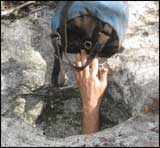 Hidden Treasures
Hidden Treasures
of the Texas Hill Country
By Kathleen O'Connor
First, a little background information on how this all came to be. During the Cretaceous Period (about 145- 65 million years ago), central Texas was covered by a shallow sea filled with a multitude of life forms, many of which were comprised of calciferous skeletons or shells. These formed deposits on the sea floor after the animals died. As layers and layers of these accumulated through vast stretches of time and compression, limestone was formed. Then about 25 million years ago, after the sea had already receded for the last time, the Edwards Plateau underwent a series of uplifts as a result of tectonic motion. The permeable Edwards limestone was then carved out like Swiss cheese thanks to the intake of rainwater through surface fissures and fractures. This type of landscape, created by the dissolution of limestone and characterized by fissures, sinkholes, and caves is called karst.
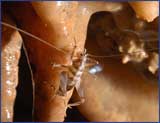 The unique conditions found in caves, along with years of isolation, have produced a fascinating and rich biota. Here we find species with adaptations that perfectly reflect their rich, subterranean history – long appendages for greater sensory reach, absence of eyes and pigmentation, and reduced metabolic and reproductive rates. It is theorized that these cave-adapted species originated from surface populations that may have retreated into caves to escaped inhospitable conditions above ground. Geologic and hydrologic barriers may have contributed to increased isolation which, in turn, led to greater adaptation to life underground.
The unique conditions found in caves, along with years of isolation, have produced a fascinating and rich biota. Here we find species with adaptations that perfectly reflect their rich, subterranean history – long appendages for greater sensory reach, absence of eyes and pigmentation, and reduced metabolic and reproductive rates. It is theorized that these cave-adapted species originated from surface populations that may have retreated into caves to escaped inhospitable conditions above ground. Geologic and hydrologic barriers may have contributed to increased isolation which, in turn, led to greater adaptation to life underground.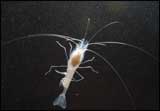
In central Texas, this has produced a rich and diverse faunal assemblage found nowhere else in the world. These cave-adapted species that cannot survive outside the cave environment are known as troglobites. Texas members of this group include some spiders, beetles,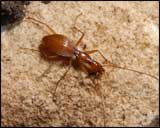 millipedes, harvestman, salamanders, isopods and catfish, amongst others. But they aren't alone. Other animals play a part in this underground community as well. Troglophiles are animals that are found in caves but are not necessarily tied to it for survival. They may be found in similar habitats outside of the cave environment, such as in the leaf litter or under logs and rocks. Some salamanders and scorpions are included in this group.
millipedes, harvestman, salamanders, isopods and catfish, amongst others. But they aren't alone. Other animals play a part in this underground community as well. Troglophiles are animals that are found in caves but are not necessarily tied to it for survival. They may be found in similar habitats outside of the cave environment, such as in the leaf litter or under logs and rocks. Some salamanders and scorpions are included in this group. 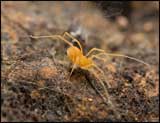 Trogloxenes, such as bats and crickets, will utilize caves as a temporary shelter but still spend a substantial amount of their time on the surface. It is upon these trogloxenes and other surface community components, such as leaf litter and organic debris, that the cave ecosystem is most dependent on for nutrient and energy input. In addition to providing nutrients, the surface
Trogloxenes, such as bats and crickets, will utilize caves as a temporary shelter but still spend a substantial amount of their time on the surface. It is upon these trogloxenes and other surface community components, such as leaf litter and organic debris, that the cave ecosystem is most dependent on for nutrient and energy input. In addition to providing nutrients, the surface 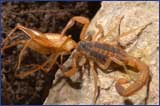 plant community also acts as a buffer, protecting the karst ecosystem against perturbations to temperature and moisture regimes required by these troglobites. Surface communities are significant for the cave crickets, too. They are known to venture from the cave at night in order to forage for food, sometimes over 100 meters from the cave entrance. When they return, they bring an energy source with them in the form of eggs, guano and also their carcasses when they die.
plant community also acts as a buffer, protecting the karst ecosystem against perturbations to temperature and moisture regimes required by these troglobites. Surface communities are significant for the cave crickets, too. They are known to venture from the cave at night in order to forage for food, sometimes over 100 meters from the cave entrance. When they return, they bring an energy source with them in the form of eggs, guano and also their carcasses when they die. 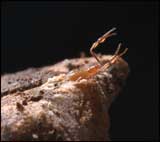 This, in turn, serves as a food source for resident troglophiles and troglobites in the cave. Consequently, cave crickets can be considered a keystone species within this unique ecosystem. For all of these reasons, protection of the vegetative surface communities surrounding the cave entrance is of vital importance.
This, in turn, serves as a food source for resident troglophiles and troglobites in the cave. Consequently, cave crickets can be considered a keystone species within this unique ecosystem. For all of these reasons, protection of the vegetative surface communities surrounding the cave entrance is of vital importance.
The conservation of karst terrain is important, particularly in light of another example found here in central Texas: The Edwards Aquifer. This underground water source is located on the eastern edge of the Edwards Plateau and provides water and recreation to close to 2 million people. The interrelationship between karst terrain and groundwater is not difficult to grasp. As surface water travels through karst features such as cave openings, fractures and sinkholes, it carries with it any contaminants it may have picked up along the way, such as herbicides, pesticides and urban runoff. These features have little or no filtration system for traveling water and over the Aquifer's recharge zone, they serve as direct conduits to this underground water supply. This makes for tremendous pollution potential. The Edwards Aquifer and its artesian springs are also home to at least 50 unique aquatic species, including cave-adapted crustaceans, salamanders and two species of catfish. Like their terrestrial counterparts, these are species found nowhere else in the world. Protecting these species and the karst habitats upon which they depend upon ultimately benefits us as well as them.
Currently, there are sixteen karst invertebrates from both the San Antonio and Austin regions have been listed as endangered by the U.S. Fish and Wildlife Service. Fourteen more species associated with the Edwards Aquifer have been listed as endangered or threatened as well. Efforts are ongoing to monitor and protect these fragile habitats and the rare species that occur within them. For example, biologists from the City of Austin's Wildland Conservation Division and from Travis County's Transportation and Natural Resources Division conduct seasonal biomonitoring inside caves known to contain endangered karst invertebrates. Through their efforts, a better understanding of the population dynamics and habitat requirements of these species may be gained.
Organizations like the Texas Speleological Survey (TSS) and the Texas Cave Management Association (TCMA) are also doing their part to conserve and educate the public on everything karst here in Texas. TSS serves as a storehouse of data on Texas karst for educational, scientific and conservation purposes, while TCMA works with members and partners to acquire and manage caves and karst for protection.
For more information on karst biology and conservation in Texas, see the following websites:
Texas Cave Critters – http://www.texasento.net/cave.htm
City of Austin – http://www.ci.austin.tx.us/water/wildland/karstinvertebrates.htm
The Edwards Aquifer Website – http://www.edwardsaquifer.net/index.html
Texas Speleological Survey – http://www.utexas.edu/tmm/sponsored_sites/tss/
Texas Cave Management Association – http://www.tcmacaves.org/index.html
Kathleen O'Connor is a consultant with Zara Environmental LLC out of Austin.
The Importance
of Springs
By Ryan McGillicuddy and Gary Garrett
Fish in general are limited in their options of where they can live. Unlike humans and many terrestrial species that can move across the landscape in search of suitable habitats, fish are constrained to where the water can take them, and are often further restricted by physical barriers within waterways, such as dams. For aquatic species adapted to spring environments these constraints can be even more extreme. For example, some fish that live in spring-fed waterways require clean, clear water with temperatures that remain relatively constant. These conditions might only be found in specific areas within a given watershed, preventing these fish from migrating to other areas of like habitat and mingling with other populations. Such habitat barriers can keep populations isolated, leading to specialized adaptations and genetic variations, even in areas not geographically distant from one another. When a species is found exclusively in one area or a very specific range, it is referred to as an endemic species.
Because the ranges of many spring-dependent fish species are often very small and the available habitat limited, they are very vulnerable to pollution and habitat alteration. By far the largest threats to these fish in Texas are habitat loss due to the over-pumping of groundwater and the associated reductions in spring flows, and hybridization with other fish species. Unfortunately, many unique species and their surrounding habitats have been severely impacted in the past century.
The San Marcos Springs are the second largest spring system in Texas and form the headwaters of the San Marcos River. Here the San Marcos Gambusia (Gambusia georgei), a small fish found only in these headwaters, is threatened by reduced spring flows and the introduction of non-native species that may prey on them, replace or destroy aquatic vegetation used as habitat, or compete with them for food. The last San Marcos Gambusia was collected in 1983 and may already be extinct.
Two more species, the Comanche Springs Pupfish (Cyprinodon elegans) and the Pecos Gambusia (Gambusia nobilis) were extirpated (completely removed) from Comanche Springs in 1955 when the springs first went dry, a result of severe drought coupled with increased demand for groundwater to irrigate agricultural fields in the area. Comanche Springs was one of the largest springs in Texas (more than 22 million gallons per day) but now only flows occasionally when there is no irrigation demand. People also suffer when their water sources vanish. Farmers who depended on surface irrigation water from Comanche Springs lost their livelihood when the springs went dry. Both fish species still survive in the Balmorhea area in waters that emerge from San Solomon and other smaller springs, as well as in irrigation canals in the area; however their existence remains tenuous due to diminishing spring flows.
The Amistad Gambusia (Gambusia amistadensis), a species that was found only in Goodenough Springs, was extirpated after the construction of Amistad Reservoir in 1968 submerged the area under 70 feet of water. Goodenough Springs were the third largest in Texas prior to their inundation. Refuge populations of the Amistad Gambusia suffered from hybridization and the species was declared extinct in 1987.
The loss or imperilment of such species forces us to ask a number of questions. For many people the first one that comes to mind is "Why should I care?" This is a very natural question to ask, especially when the value of a species may not be immediately apparent, perhaps because it is small or not exploited for commerce or recreation. However there are numerous reasons to preserve and protect such species, including fish found in the spring-fed streams of Texas.
Many small species, such the gambusia and pupfish mentioned above, serve to inform us about the overall health and well being of a specific habitat or ecosystem. These are often referred to as indicator species. If a species that is specifically adapted to particular location does not seem to be faring well, it can offer us insight into the biological condition of the watershed at large.
Maintaining diversity is another reason for protecting such species. All organisms in an ecosystem are part of a complex web of relationships, with species depending on one another for their survival. Small fishes may feed on decomposing organic matter, algae, and small invertebrates. They are themselves eaten by larger fish and reptiles, which in turn are eaten by birds, small mammals, and game animals that likewise play their own integral role in the ecosystem. Maintaining a diverse array of species helps to ensure the health of the entire system, while removing even small parts of the web may have a detrimental effect.
Ensuring that there is adequate water for these species to survive also ensures that there will be water for human uses. If water is over-pumped or poorly managed spring flows may cease, effectively turning off the faucet that supports the aquatic systems we rely on for irrigation, water supply, and recreation. While in extreme circumstances federal regulators may mandate that minimum spring flows be maintained for the survival of a threatened or endangered species, this is always an undesirable outcome. Instead, it is better for all water users if a proactive approach can be taken to ensure there is enough water to support human uses and our natural heritage alike.
Texas Parks and Wildlife Department has worked to restore many of these habitats and resolve non-game species problems through cooperative programs with local governments and especially private landowners. This has been exemplified by the creation of a "natural" ciénega (desert wetland) for Comanche Springs Pupfish and the Pecos Gambusia at Balmorhea State Park within the boundaries of the original, natural ciénega. As a result, the native flora and fauna have flourished. This location now provides a natural habitat and contains the largest known concentration of Comanche Springs pupfish. The Department is now constructing a second ciénega at Balmorhea State Park to be completed in spring 2010.
Another example of this collaborative type of approach is the Edwards Aquifer Recovery Implementation Program. The waters of the Edwards Aquifer support numerous unique plant and animal species threatened by the reduction of flows due to over-pumping and drought. This voluntary, multi-stakeholder initiative has drawn together a diverse group of participants who are currently developing a program that will balance water use and the needs of federally listed species.
Involving individuals and local governments in conservation of species and their habitats increases the likelihood of achieving long-term benefits for natural resources as well as protection of these resources for the public. Texas has been called a land of springs. By working together we can make sure that future generations will know it this way too.
Ryan is a conservation ecologist working with the Inland Fisheries Division of Texas Parks and Wildlife Department in Austin. Gary is Program Director of Watershed Policy and Management working out of Mountain Home, TX
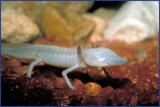 Blind Monster
Blind Monster
By Andy Gluesenkamp
The Texas blind salamander (Eurycea rathbuni) was formerly described as Typhlomolge rathbuni (Typhlomolge means "blind monster") in 1896. Over a century later, it is one of the most famous amphibians on earth. It was one of the first species placed on the Federal Endangered Species list and, despite the fact that it has long fascinated scientists and the public alike, few people have ever seen one and little is known about its life history or population status.
Other closely related species have been discovered living elsewhere along the Balcones Fault Zone. The Blanco blind salamander (Eurycea robusta) is known from a single specimen collected in a hand dug crevice in the bed of the Blanco River in 1951. The Austin blind salamander (Eurycea waterlooensis) was described in 2000 and is known only from Barton Springs in Austin. More recently, a fourth species was discovered in wells and springs in New Braunfels. All of these species are thought to inhabit aquifer habitat and only rarely do hapless individuals emerge from large springs emanating from aquifer sources. All members of the subgenus Typhlomolge are blind with shovel-shaped heads and long spindly legs. They have greatly reduced pigmentation which gives them a pearlescent appearance. Compared to related surface species found in some of the same springs, they are giants. Members of this group may be three times the size of surface congeners. This large size likely reflects a release from strong selective pressures associated with surface living.
All blind salamanders are totally dependent on groundwater. Therefore reduction in the quality and quantity of water in the Edwards Aquifer poses the greatest threat to their existence. Some of the greatest threats: heedless development and water mining are best addressed though a suite of efforts including legislation, public education, and conservation incentives. Protecting groundwater is an enormous challenge both in terms of the scale of the endeavor and in terms of political appeal and public sentiment. However, these organisms are perhaps the most striking examples of the incredible biodiversity found in Texas and are a treasure that, hopefully, will be shared with future generations.
Andy Gluesenkamp is the herpetologist working out of Austin headquarters for Texas Parks and Wildlife Department.
On Land Management
and Texas Springs
By Chad Norris
These habitats are recognized for their unique biota that often includes rare, endemic, and relict species. The presence of such species is often owed to the hydrologic stability displayed by many springs in terms of the quantity and quality of water discharged over time. Because of their relative stability (as compared to streams and reservoirs), springs are also important in keeping some of Texas' common aquatic and aquatic dependent species common by providing baseflows to rivers and streams and serving as isolated refuges during environmental extremes. Springs also often maintain downstream aquatic and riparian habitats, enhance and/or sustain surface water supplies, among other benefits.
Many aquatic species are adapted to and have specific requirements related to natural flow regimes. Springs are an important component of the natural flow regime in many river basins because they provide important baseflows and in some cases contribute to freshwater inflows to bays and estuaries. Baseflows sustain aquatic and aquatic dependent ecosystems during periods of drought, including instream, riparian, and wetland habitats. The role of wetland and riparian habitats in maintaining healthy aquatic ecosystems by filtering sediments and pollutants from water, attenuating floodwaters, controlling erosion, and providing high quality wildlife habitat cannot be overstated. Because springs are often the only perennial source of surface water, especially in arid regions, maintaining springflows is an important component of conserving these vital habitats.
While recognizing that springflows had declined considerably, Gunnar Brune (1981) estimated the total flow of Texas' springs to be in excess of 4,132 cubic feet per second, or almost three million acre-feet per year (AFY). This volume of water equals about 33 percent of the estimated 9 million AFY of total surface water available for use in 2010 and constitutes a significant contribution to the surface water supplies of the state. Because surface water availability analysis in Texas is generally based on historical streamflows, reductions in springflows may reduce actual streamflows to levels below that predicted. During extended drought conditions, this could have a significant impact on the availability of surface water for municipal, industrial, agricultural, and other uses.
Texas Springs
Texas springs are distributed in clusters from the eastern portion of the panhandle, the southwestern portion of the Big Bend region, in a band that follows the Carrizo-Wilcox Aquifer from south central Texas northeasterly towards Texarkana, with the highest concentration of springs occurring throughout the Edwards Plateau. In general, the density of springs appears greatest in headwater regions and is remarkably low in the lower reaches of large river basins. This may be due to physiographic differences between headwaters and lower reaches of river systems, but may also be the result of an incomplete dataset.
The headwaters of many Texas rivers, including the Colorado, Llano, Guadalupe, Blanco, Medina, Frio, Sabinal, and Nueces are formed by springs that drain the Edwards Plateau of south central Texas. The karst terrain of this region promotes groundwater-surface water interactions and is ideal for spring development. Nowhere in the state are springs more important for sustaining aquatic habitats than in the Edwards Plateau Ecoregion. This ecoregion has the highest degree of endemism for animal and plant species in the state and also has the highest concentration of springs. Of the springs identified in the state, the majority (about 40%), including the 15 largest springs, issue from the Edwards and associated limestones that underlie the Edwards Plateau Ecoregion.
While large (10-100 cfs average discharge) to very large springs (> 100 cfs average discharge), such as Comal, San Marcos, Barton, and San Felipe springs, likely account for a large proportion of the total flow of Texas' springs, the importance of individual smaller springs cannot be overstated. Based on analysis of available discharge measurements, a majority (>80%) of Texas' springs are very small (0.001 to 0.01 cfs) to moderately large (1 to 10 cfs) in size. While the extent of habitat they support at the spring orifice may appear small, the cumulative flow from these small to moderately large springs often composes a significant portion of streamflows, especially during drought.
Similarly, the biological importance of a particular spring is not determined by the volume of flow produced but appears to be more affected by the persistence of flow. Many rare and endemic Texas species are found in spring habitats that display relatively low flows (0.01 to 1.0 cfs) and support limited habitat. In many cases, such as environmental assessments associated with water planning and development, these springs are thought of as insignificant. Smaller springs may be relatively insignificant in terms of water volume produced, but the habitats they sustain harbor a disproportionately high number of rare and endemic species and the cumulative effect of their flow is key to perennial streams in the Texas Hill Country, making them a high conservation priority.
Threats to Texas Springs
As Texas' population grows, demands on land and groundwater resources also increase. Because the loss and decline of Texas Springs has been well documented, many are concerned about potential impacts to springs. Primary threats to spring habitats and their associated biota include groundwater pumping, development within recharge zones, and poor land management practices, among others.
The utilization of groundwater resources results in increased capture of local recharge and/or withdrawal of groundwater from storage. Groundwater withdrawals associated with agricultural and municipal uses have impacted many of our states largest springs (i.e., San Antonio, Comanche, and Phantom Lake springs among others). Such large springs are generally recharged by water that has infiltrated at various locations, sometimes originating great distances from the spring source. Such extensive underground flow systems typically produce high volume, persistent springs, which is why many have been tapped into as a municipal or agricultural water source.
In most cases, smaller springs found throughout the Edwards Plateau have localized recharge and flow zones, often limited to the area immediately upslope of the spring. For these springs, land management practices in recharge zones play an important role in maintaining the quantity and quality of water produced by the springs.
Development and/or degradation within recharge zones and zones that contribute to recharge, in many cases, effectively reduces recharge to the aquifer by increasing impervious cover and/or promoting surface runoff. As a result, the quantity and quality of water that infiltrates into the aquifer as recharge is decreased. As Texas continues to grow, proper land management practices in recharge and contributing zones will become increasingly important for maintaining the quantity and quality of springflows.
Land management practices such as grazing, farming, and brush clearing can affect springs. For example, overgrazed rangelands promote soil compaction that can effectively reduce recharge to aquifers by impeding the downward movement of water and increasing surface runoff. Plowing and clearcutting on steep hillsides can cause severe erosion that results in sedimentation and reduces stream shading and organic inputs (i.e., leaves, woody debris, etc…) to spring habitats. Livestock grazing at springs and on streambanks often results in trampling of riparian habitats, which destabilizes banks and increases erosion. Sedimentation from erosion can impact spring habitats by burying the spring orifice and reducing both the quantity and quality of springflows.
One land management practice that has gained much attention over the years is the removal of woody plants (primarily Ashe Juniper, which is commonly referred to as cedar in Texas) or shrubs that have encroached on historical rangelands. As mentioned previously, the loss and decline of Texas springs over the last century has been well documented. During this period, groundwater pumping greatly increased and woody plant cover has increased significantly. While intense groundwater pumping has been proven to be the cause of reduced springflows at particular springs (e.g., Comanche and San Antonio springs), the effects of woody plant encroachment on springflows is less clear.
There are numerous accounts of rejuvenation of Texas springs after woody plant cover was reduced. Perhaps the most publicized example of this is the Bamberger Ranch in Blanco County where springs were seemingly rejuvenated after reducing grazing, clearing Ashe juniper, and establishing native grasses. While similar stories have been reported throughout the Texas Hill Country, evidence to support claims that springflow increases resulted from Ashe juniper removal are mainly anecdotal.
Studies investigating the connection between woody plant cover removal and springflows in Texas have had somewhat differing results. Perhaps the first study that reported an increase in springflow following Ashe juniper removal was performed on an 8 acre watershed catchment in the Seco Creek watershed. The author reported that springflow increased from 11.8 liters/minute (l/min) to 14.3 l/min following Ashe juniper removal. This study is commonly cited as proof that Ashe juniper removal leads to increased water yield. However, the report does not describe the methodologies, calculations, and assumptions used in the study. Because there are many factors that affect springflows, including antecedent rainfall and groundwater levels as well as vegetation that establishes in place of Ashe juniper, the results of the study should be viewed as inconclusive.
Subsequent studies on the effect of Ashe juniper removal on springflows have had varied, but insightful results. A study in the western Edwards Plateau of Central Texas, where springs were not originally present, found that streamflows did not increase following the removal of Ashe juniper. The authors hypothesized that woody plant removal would augment streamflow only if springs are or have been present naturally. In other words, removing woody plant cover does not "create" springs. The necessary plumbing (i.e. aquifer and associated flow system) needs to be in place in order for precipitation to be received, stored, and transmitted to springs.
More recent research by Texas A&M studied runoff generation for a site on the Edwards Plateau following the removal of woody plant cover for a first-order rangeland catchment supplied with intermittent streamflow from a spring at its base. After monitoring streamflow for 4 years (two before woody plant removal and two following removal), the authors reported, among other results related to runoff/precipitation ratios, that streamflow increased following the removal of Ashe juniper, except during summer months. More precisely, the authors reported removing approximately 60% of the Ashe juniper in the catchment resulted in increased streamflow of approximately 46 mm/year, or 5% of annual precipitation, but only for non-summer precipitation events. It is unclear if such increases in streamflow persist following treatment, how variable results are with climate and location, or if these results are applicable on a larger scale.
While the ultimate success of removing Ashe juniper and other woody plants as a means of increasing streamflow is unclear, there are other benefits to removing Ashe juniper in the proper proportion (approximately 60% removal). Many of the areas now dominated by Ashe juniper were historic grasslands maintained by buffalo migrations and fire. As buffalo were eradicated and fire has been suppressed, cedar has encroached on much of our native prairies in the Edwards Plateau. Removing Ashe juniper provides the perfect opportunity for reestablishing native prairie grasses to their historic range. This restores the native habitat, but also works to improve the quality of water that recharges into the underlying aquifer as the grasses extensive root systems aid in filtering the infiltrated water.
One thing is clear, for the state of Texas to be successful in conserving the vital spring resources associated with the Edwards Plateau, we will need the assistance of private landowners whose properties provide much of the recharge that sustains our state’s springs. Many private landowners have implemented land management strategies, such as woody plant removal, the reestablishment of native prairies and maintenance of those prairies through prescribed burns and/or rotational grazing, and riparian restoration, that ultimately provide water quality and quantity benefits to us all. Additionally, many landowners are placing conservation easements on their properties to ensure their properties are conserved for future generations, which again ultimately benefits us all in terms of the quality and quantity of water recharging aquifers and running off into creeks, streams, and rivers.
References:
Brune, Gunnar. 1975. Major and Historical Springs of Texas. Texas Water Development Board Report No, 189. Austin, Texas. Available online: Major and Historical Springs of Texas.
Brune, Gunnar. 1981. Springs of Texas. Texas A&M Press. College Station, Texas.
Chad Norris is a Natural Resource Specialist with Coastal Fisheries working out of Austin.
What is Good for Texas Salamanders
is Good for People
By Paul Chippindale
Although somewhat similar in appearance to lizards, salamanders are actually amphibians, most closely related to frogs. Unlike many other salamanders, which go through an aquatic larval stage and then lose their gills and move onto land, the Eurycea of the Aquifer region keep their gills and other larval features throughout their lives. This represents an adaptation to life in harsh countryside unsuitable for animals, such as salamanders, that must keep their skin continuously moist.
The Aquifer's complex structure has created a series of "islands" of aquatic habitat within an "ocean" of hot, dry land. This has given rise to numerous previously unrecognized species with very limited distributions. Many localized species of salamanders superficially resemble one another, yet modern methods such as DNA sequencing have revealed great diversity in the group and many ancient divergences. For example, the Colorado River, which flows through the city of Austin, marks the divide between two groups of Eurycea that split from each other about 15 million years ago even though to the untrained (and sometimes trained!) eye, many salamanders from north versus south of the river are very difficult to tell apart. On the other hand, often closely related spring and cave-dwelling populations occur in the same area, but even distantly related cave-dwellers have evolved similar features as a result of their subterranean lifestyles. For decades this further complicated our understanding of biodiversity in the group, until it became possible to identify unique characteristics of their DNA.
The Aquifer is a critical source of drinking water for the millions of people who live in the Hill Country region, most in and around the cities of Austin and San Antonio along the southeastern edge of the Plateau. Its cool, clear waters also provide many recreational opportunities. For example, every year hundreds of thousands of people visit Barton Springs in the heart of Austin and swim alongside two species of salamanders (the Barton Springs salamander and the Austin blind salamander) that are known only from the small part of the Aquifer that feeds the springs. This is just one example of a natural resource that is essential to both wildlife and humans, and the challenge is to preserve the Aquifer's water quality and flow as the human population continues to expand. What's good for salamanders is good for people!
Paul is professor of Biology at UT Arlington.
Did You Know…
Threats to Listed Karst Invertebrates:
- Urban Development
- Filling in and the collapse of karst features
- Alteration of surface community
- Alteration of surface and subsurface drainage patterns
- Red-imported fire ants
- Contamination/Dumping into karst features
- Vandalism
Did You Know…
The brushland of south Texas is home of some of the richest biodiversity in North America.
Did You Know…
The ocelot, once found throughout south and central Texas at least as far north as the Houston area is now limited to Hidalgo, Cameron, Starr and Willacy Counties.
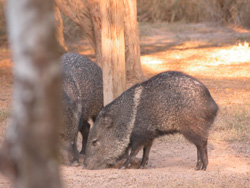
Javelina
Did You Know…
The last confirmed sighting of a jaguarondi in Texas was made in 1986 near Brownsville, Texas.
Did You Know…
The four counties of the Lower Rio Grande Valley have recorded more butterfly species than other states in the Union.
Did You Know…
Many of the trees, shrubs and other plants of the South Texas Brushlands can be found no where else in Texas.
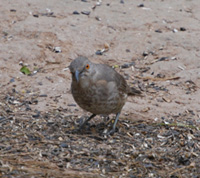
Curve Billed Thrasher
Did You Know…
Jaguars could once be found in south Texas.

 Texas Parks and Wildlife Department, 4200 Smith School Road, Austin, TX 78744
Texas Parks and Wildlife Department, 4200 Smith School Road, Austin, TX 78744


